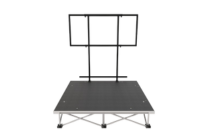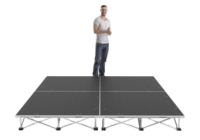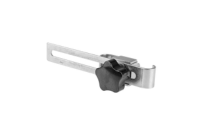Lightweight Staging
Lightweight staging has become the preferred choice wherever rapid set-up, simple handling and minimal storage demands matter. From rehearsal rooms in secondary school staging to temporary presentation areas in civic halls, these compact platforms take the strain out of creating a raised surface. Traditional assemblies built from dense timber or heavy steel once required multiple technicians and long changeover windows. Today, a small team or even a single caretaker can position a complete lightweight stage in minutes and then move on to the next task.
Why Lightweight Platforms Stand Out
- Minimal effort during transport and installation, even up stairwells or through narrow doorways.
- Tool-free leg or brace attachment on most models speeds up assembly and keeps downtime brief.
- Compact stacking footprints permit storage in a cupboard rather than a dedicated warehouse bay.
- Module-based design produces countless layouts without investing in separate, specialist builds.
The shift towards lighter hardware is not purely convenience-driven. Reduced manual handling lowers the likelihood of injury, while fewer vehicle journeys for event equipment keep logistics costs down. Organisers, facility managers and tutors gain genuine budget and time savings over the life of the kit.
Lightweight Platforms' Materials and Engineering
A lightweight stage platform rarely relies on a single substance. Manufacturers blend high-grade plywood cores, honeycomb composites and slimline metal frames to achieve low mass without compromising stiffness. The working load rating on reputable systems exceeds the requirements of group performances, ensuring peace of mind during energetic dance numbers or ensemble music pieces.
- Multi-layer board surfaces deliver both strength and acoustic neutrality.
- Anti-slip laminates or grit finishes maintain grip under stage lighting glare.
- Integrated edge trims protect the core material during repeated loading cycles.
- Positive locking systems between panels prevent drift once everything is in place.
Lightweight Stage Configurations and Shapes
No two venues share identical dimensions, so flexibility lies at the heart of modern lightweight staging boards. Square, rectangular and triangular formats combine to form arcs, cat-corner layouts or full rectangles depending on the brief. Tiering blocks add elevation when required, yet remain removable for flat-floor events the very next day.
A single investment therefore covers assemblies, music recitals, fashion demonstrations and award evenings. Where demand increases, additional lightweight platforms purchased later slot straight into the existing stock courtesy of matching locating features and common heights.
Typical Sectors Making the Switch to Lightweight Portable Stage
- Education – daily timetable changes favour equipment that one caretaker can reposition between lessons.
- Community organisations – halls serving fitness classes at noon and amateur dramatics at night need staging that vanishes quickly.
- Performance troupes – touring productions appreciate gear that loads into a small van rather than an articulated lorry.
- Corporate events – product demonstrations within exhibition suites often request a fast, neat platform that leaves no trace once the stand closes.
Handling and Storage Good Practice
Moving several panels at once is best achieved with purpose-built trolleys fitted with soft wheels. The boards sit vertically, strapped to prevent sideways movement. Even when hand-carried, the manageable weight means two staff members can navigate tight corridors without difficulty.
Long-term care is uncomplicated. Keep surfaces clear of grit, wipe spills promptly and inspect locking pins or clips for wear every term. Where outdoor use is planned, dry panels thoroughly before storage to avoid trapped moisture.
Choosing the Correct Lightweight Stage Platform
Key questions influence the final specification:
- Footprint required. Measure the maximum available floor space and select enough modules to fill it while leaving clearance for steps or access.
- Loading demands. Choirs, dance troupes or heavy display pieces each impose differing weight patterns; always confirm the safe working limit.
- Frequency of moves. Regular relocation calls for integral handles or panel edges shaped for comfortable lifting.
- Finish type. A smooth laminate suits presentation lecterns, whereas a textured grip layer benefits vigorous choreography.
Once these basics are clear, selecting the right lightweight stage platform becomes a straightforward exercise. Expansion later remains viable, so initial orders rarely need to cover every scenario from day one.
Maintaining Lightweight Staging Boards
Despite the reduced heft, a lightweight portable stage supports full production values. Line arrays, back-line amplifiers and scenery flats all find solid footing providing overall limits are respected. Non-slip coatings retain traction beneath stage lights, while perimeter trims give a clean finish for live camera work.
Key Benefits in a Snapshot
- Swift set-up handled by limited personnel.
- Load ratings that rival heavier predecessors.
- Adaptable shapes for unusual floorplans.
- Cost savings on transport, labour and storage.
- Professional appearance suitable for any public-facing event.


























